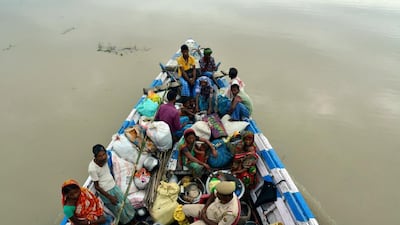While international attention remains on China's expansionist activities in the South China Sea's disputed waters, Beijing is quietly focusing on other waters also — of rivers that originate in Chinese-controlled territory like Tibet and flow to other countries. This shows that China's new obsession is freshwater, a life-supporting resource whose growing shortages are casting a cloud over Asia's economic future.
By building cascades of large dams on international rivers just before they leave its territory, China is re-engineering cross-border natural flows. Among the rivers it has targeted are the Mekong, the lifeline of South East Asia, and the Brahmaputra, the lifeblood for Bangladesh and north-eastern India.
With the world’s most resource-hungry economy, China has gone into overdrive to corner natural resources. On the most essential resource, freshwater, it is seeking to become the upstream controller by manipulating trans-boundary flows through dams and other structures.
China now controls vast transnational water resources. By forcibly absorbing Asia's "water tower", the Tibetan plateau, in 1951, it gained a throttlehold over the headwaters of Asia's major river systems. Its actions in more recent years have sought to build water leverage over its downstream neighbours.
Such an approach has fostered increasing water-related tensions with India, most of whose northern rivers originate in Tibet. In 2017, in violation of two legally binding bilateral accords, China refused to supply hydrological data to India.
________________________
Read more from Opinion:
HA Hellyer: Egypt church attack requires a broad response from an empowered civil society
Are we witnessing a broad reorientation of US politics in the Trump era?
_______________________
For much of the past summer, China and India were locked in a border standoff in the disputed Himalayan territory of Doklam. But before the troop standoff flared in mid-June, Beijing was already seething over India's boycott of its Belt and Road Initiative summit in May. The denial of data began as an attempt to punish India for the summit boycott, with the punitive intent being reinforced by the subsequent Doklam standoff.
Flash-flood modelling, by employing timely and reliable data on upstream water levels, can help save lives and reduce material losses. The 2017 monsoon rains were below normal in India's north-east, through which the Tibet-originating Brahmaputra River flows before entering Bangladesh. Yet the monsoon-swollen Brahmaputra caused record flooding that left a major trail of death and destruction, especially in India's Assam state. Some of these deaths might have been prevented had China's data denial not crimped India's flood early-warning systems.
Even as Beijing has yet to indicate if it would resume sharing data in 2018, a major new water-related issue has cropped up in its relations with India — the water in the main artery of the Brahmaputra River system, the Siang, has turned dirty and grey when it enters India from Tibet. This has spurred downstream concern in India and elsewhere that China’s upstream activities could be threatening the ecosystem health of the cross-border rivers in the way it has polluted its own domestic rivers, including the Yellow, the cradle of the Chinese civilisation.
After staying quiet over the Siang’s contamination for many weeks, despite the furore in India, Beijing claimed on December 27 that an earthquake that struck south-eastern Tibet in mid-November “might have led to the turbidity” in the river waters. But the flows of the Siang, one of the world’s most pristine rivers, turned virtually black much before mid-November, suggesting another factor was possibly behind the contamination.
China has been engaged in major mining and dam-building activities in south-eastern Tibet. The Tibetan plateau is a treasure-trove of minerals.
The Brahmaputra and its tributaries are a huge magnet for China’s dam builders because their combined cross-border flows are larger than the collective trans-boundary flows of the three key rivers running from the Tibetan Plateau to South East Asia: the Mekong, the Salween and the Irrawaddy.
China is already home to more than half of the globe's large dams. To deflect attention from its continuing dam-building frenzy and its refusal to enter into a water-sharing treaty with any neighbour, China has bragged about its hydrological-data sharing accords. Yet it showed in 2017 that it can breach these accords at will.
Such is China’s defiant unilateralism that, to complete a major dam project, it cut off the flow of a Brahmaputra tributary, the Xiabuqu, in 2016 and is currently damming another such tributary, the Lhasa River, into a series of artificial lakes.
The cause of the Siang River’s contamination can be known only if China agrees to a joint probe with India, including a survey of the river’s upper reaches in Tibet. That is the only way to get to the bottom of this contamination that has choked aquatic life.
By building increasing control over cross-border water resources, China is dragging its neighbours into high-stakes games of geopolitical poker over water-related issues. In waging water wars by stealth, China seeks to hew to the central principle enunciated by the ancient military theorist Sun Tzu: "All wars are based on deception."
Brahma Chellaney is a geo-strategist and author of nine books, including Water: Asia's New Battleground, which won the Bernard Schwartz Award

